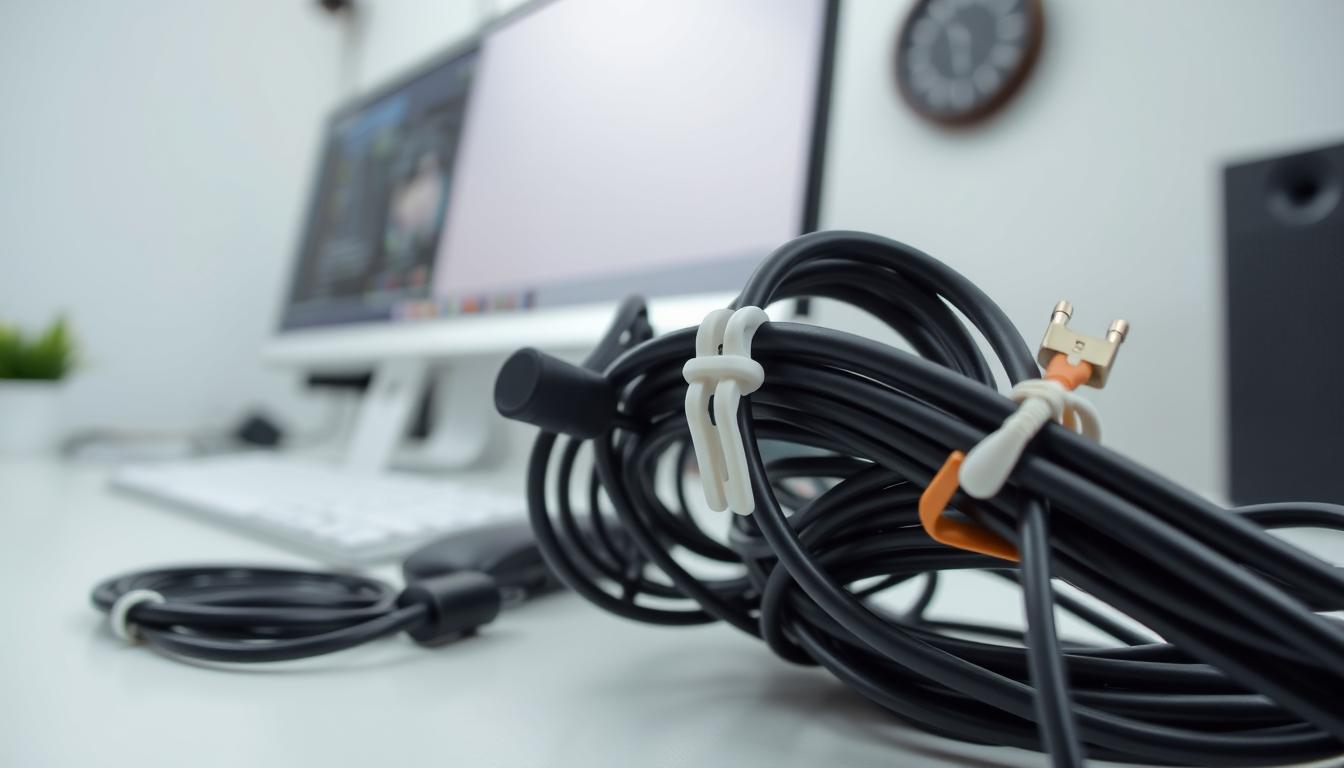Effective wire management is key to a tidy and efficient workspace. It uses various methods and tools to keep cables and wires organized. This approach boosts productivity and safety. It’s vital for any workspace, from home offices to large commercial areas.
By organizing wires well, you lower accident risks, improve air flow, and make your space look better. It’s not just about hiding cables. It’s about setting up a system that’s easy to keep up and expand.
A clean installation ensures cables and wires are secure, labeled, and in the right place. This makes your workspace safer and reduces damage risks. With a good cable management system, finding and fixing problems becomes easier.
Investing in a professional wire management system brings many benefits. It improves productivity and safety. In this guide, we’ll dive into why wire management is important. We’ll also share tips for a clean and efficient setup.
Key Takeaways
- Effective wire management is essential for a clutter-free and efficient workspace
- A well-planned wire organization strategy can reduce the risk of accidents and improve airflow
- Cable management is crucial for ensuring the safety and maintenance of equipment and cables
- A clean installation is essential for easy troubleshooting and maintenance
- Investing in a professional wire management system can improve productivity and enhance safety
- Wire management, cable management, and wire organization are critical components of a well-designed workspace
Understanding Wire Management Fundamentals
Effective wire organization is key for a neat installation. It ensures cables are routed and managed well. This makes the installation look better and lowers accident risks.
Wire routing is vital in wire management. It’s about planning and placing cables to avoid clutter and boost performance.
There are important principles in wire management. These are planning, organization, and execution. Following these helps make wire management systems efficient, effective, and safe. Organized cable systems improve safety, reduce clutter, and look better.
What Is Professional Wire Management
Professional wire management uses special tools and techniques. It includes using cable ties and wire looms to keep cables neat. It’s crucial for many places, from home offices to big commercial setups.
Benefits of Organized Cable Systems
Organized cable systems have many benefits. They improve safety, reduce clutter, and look better. Keeping cables tidy and secure lowers accident risks and enhances the installation’s look.
- Improved safety
- Reduced clutter
- Enhanced aesthetics
- Increased efficiency
- Reduced maintenance costs
Basic Principles of Cable Organization
The basics of cable organization are planning, organization, and execution. It involves assessing needs, choosing tools, and safely executing the plan. Following these principles ensures cable management systems are effective, efficient, and safe.
Essential Tools and Materials for Cable Management
Effective cable management starts with the right tools and materials. You’ll need various cables, connectors, and management systems. Also, tools for installation and upkeep are key. Installation techniques differ by project, but a good toolkit is vital for success.
Begin with basic tools like wire cutters, strippers, and crimpers. You’ll also need cables and connectors, such as Ethernet and USB. For tougher tasks, tools like cable testers and label makers might be needed.
Here’s what you’ll need for top-notch cable management:
- Cables and connectors
- Wire cutters and strippers
- Crimpers and cable testers
- Label makers and labels
- Cable ties and organizers
With these tools and materials, you’re ready for any cable management challenge. You’ll use different installation techniques to keep cables tidy and safe.
Safety Considerations Before Starting
When you start a wire management project, safety is key. It helps avoid accidents and makes the installation smooth. You need to think about electrical safety, workplace safety, and emergency plans.
Good wire management needs careful planning and detail. By focusing on safety, you can make a safe place to work. This is very important in places where wire management is crucial for safety and efficiency.
Electrical Safety Guidelines
Electrical safety is very important. Make sure all electrical parts are well-insulated and wires are securely attached. Always follow lockout/tagout rules to avoid electrical shocks.
Workplace Safety Measures
Workplace safety is also crucial. This means training employees, having the right safety gear, and checking for hazards often. By doing this, you can make a safer work environment.
Emergency Procedures
Having a plan for emergencies is key. Keep a fire extinguisher ready, know how to handle electrical shocks, and have a first aid kit. This helps keep everyone safe in emergencies.
By focusing on safety, you can make a safe and efficient work area. Always follow electrical safety rules, workplace safety steps, and emergency plans. This will help your wire management project go smoothly and safely.
| Safety Consideration | Description |
|---|---|
| Electrical Safety Guidelines | Ensure proper insulation, secure fastening, and follow lockout/tagout procedures |
| Workplace Safety Measures | Provide training, ensure safety equipment, and conduct regular safety inspections |
| Emergency Procedures | Have a fire extinguisher, know how to respond to electrical shocks, and have a first aid kit available |
Planning Your Wire Management Strategy
Creating a solid wire management plan is key to a successful setup. You need to think about how to route wires and the best installation methods. This way, you can avoid problems and make the installation go smoothly.
Mapping out cable routes is a big part of planning. You should figure out the best paths for your cables, considering any obstacles or interference. A detailed map helps keep your installation organized and easy to manage.
Creating a Comprehensive Plan
To make a solid plan, follow these steps:
- Identify the types of cables you will be using and their respective routes
- Determine the best installation techniques for each type of cable
- Create a timeline for the installation process
By doing these steps, you can make sure your wire management plan works well. It will cover wire routing and installation techniques.
Good planning is essential for a wire management project. By mapping out cable routes, making diagrams, and setting a timeline, you can have a smooth installation. This uses the right wire routing and installation techniques.
Professional Wire Management Techniques
Effective wire management is key for a clean and organized setup. It uses various methods and tools to keep cables in check. Wire management is vital for any installation. It prevents cable damage, cuts down on clutter, and boosts safety.
Cable bundling is a main technique in wire management. It groups cables together with cable ties or other systems. This makes them easier to manage and route. It also reduces clutter, prevents damage, and enhances the installation’s look.
Professionals use tools like cable organizers, ties, and systems for wire management. These tools help keep cables secure and in order. By employing these tools and methods, experts can achieve a tidy and safe installation. This reduces the chance of cable damage and boosts overall safety.
- Use cable ties to bundle cables together
- Utilize cable organizers to manage and route cables
- Implement management systems to secure and maintain cables
By adding these techniques and tools to their work, professionals can enhance their wire management skills. This ensures a clean and organized installation that meets top standards.
Cable Bundling and Routing Methods
Effective cable management uses various techniques to keep cables tidy. This includes cable bundling and routing methods. These are key for a clean and efficient workspace. Cable bundling groups cables together, making them easier to manage and identify.
For wire identification, this is very helpful. It allows for quick tracing of specific cables.
There are different ways to route cables. Vertical cable management routes cables up, using ties or clips on walls or ceilings. This is great for data centers or server rooms. On the other hand, horizontal cable organization routes cables along floors or baseboards. Cable trays or conduits help keep them organized.
Under-desk solutions are also useful for cable management. They use cable organizers or trays to keep cables neat and out of the way. These methods improve workspace efficiency and safety. They also make it easier to manage and identify cables.
| Cable Management Method | Description |
|---|---|
| Vertical Cable Management | Routing cables upwards using cable ties or clips |
| Horizontal Cable Organization | Routing cables along floors or baseboards using cable trays or conduits |
| Under-Desk Solutions | Using cable organizers or trays to keep cables tidy and out of the way |
Using these cable bundling and routing methods can greatly improve workspace organization and efficiency. It also reduces the risk of accidents or errors caused by cables.
Color Coding and Labeling Systems
Effective wire identification is key for good cable management. Color coding and labeling make it easy to spot specific cables. This cuts down on mistakes and boosts safety, which is vital in complex setups.
Color coding and labeling bring many benefits. They lead to better organization, less downtime, and safer workspaces. These systems can be tailored to fit different needs, making them flexible for many cable management tasks.
To set up a color coding and labeling system, follow these steps:
- Choose a color scheme that’s easy to understand and consistent
- Label each cable with its color and ID info
- Use durable labels that can handle temperature and humidity
By using wire identification and cable management tips, you can make your cable setup efficient and safe. This not only keeps things organized but also lowers the chance of mistakes and downtime.
For more on cable management and wire identification, talk to a pro or check out industry guides. A well-thought-out cable management system ensures a safe, efficient, and reliable setup.
| Cable Type | Color Code | Label Information |
|---|---|---|
| Power Cable | Red | Voltage and current rating |
| Network Cable | Blue | Network name and IP address |
| Audio/Visual Cable | Green | Cable function and connection info |
Managing Different Types of Cables
Effective cable management is key for a tidy and efficient setup. Each cable type has its own needs and challenges. Knowing these helps in creating a custom cable management plan.
Managing cable management means looking at power, network, and audio/visual cables differently. Power cables need careful handling to avoid damage and ensure safety. Network cables must be organized to reduce signal loss and boost data flow.
Power Cables
Power cables are vital in any electrical setup. Proper wire organization helps prevent overheating, electrical shocks, and fires. Key steps for managing power cables include:
- Using cable ties and clips to secure cables and prevent damage
- Labeling cables to ensure easy identification and maintenance
- Implementing a color-coding system to differentiate between power cables and other types of cables
Network Cables
Network cables, like Ethernet cables, need careful handling for reliable data transmission. Best practices for managing network cables include:
- Using cable organizers and management systems to keep cables tidy and organized
- Implementing a cable labeling system to simplify troubleshooting and maintenance
- Regularly inspecting cables for damage or wear and tear
Audio/Visual Cables
Audio/visual cables, such as HDMI and audio cables, need careful management for quality signal transmission. Key considerations for managing audio/visual cables include:
| Cable Type | Management Considerations |
|---|---|
| Audio Cables | Using cable ties and clips to secure cables, labeling cables for easy identification |
| Video Cables | Implementing a color-coding system to differentiate between video cables and other types of cables, regularly inspecting cables for damage or wear and tear |
Understanding the unique needs of different cables helps in creating a custom cable management plan. This ensures a well-organized and efficient wire management system.
Troubleshooting Common Wire Management Issues
Effective wire management is key for any organization. Troubleshooting common issues is vital to keep systems organized. Regular troubleshooting helps find and fix problems early.
Common wire management issues include damaged cables, lost signals, and connectivity problems. To solve these, understanding your wire management system is crucial. Create a detailed diagram and check cables and connections often.
Being proactive in wire management and troubleshooting helps a lot. It cuts downtime, lowers costs, and boosts efficiency. Here’s how:
- Regularly check cables and connections
- Make a detailed diagram of your system
- Set up a maintenance schedule
By doing these, your wire management system will run well. Any problems can be found and fixed quickly through good troubleshooting.
Maintenance and Updates
Managing wires is not a one-time job. It’s an ongoing task that needs regular care and updates. This keeps the system working well. Regular checks help spot problems early, avoiding damage and accidents.
Keeping detailed records of your system is also key. This includes diagrams and repair history. Regular maintenance helps your system last longer and saves money on repairs.
Regular Inspection Schedule
Set up a regular check schedule for your wire system. This could be daily, weekly, or monthly, depending on your needs. Look for signs of wear like frayed cables or loose connections during these checks.
System Documentation
Good documentation is vital for your wire system’s upkeep. It should include system diagrams and repair records. Accurate records help track changes and spot issues early.
Upgrade Considerations
Technology changes, and so might your wire system needs. When upgrading, think about your current system and future needs. Consider wire management techniques like cable bundling to keep things organized.
Focus on maintenance and updates to keep your wire system efficient and safe. Regular checks, good documentation, and timely upgrades are crucial. These steps protect your equipment, prevent accidents, and save on repairs.
| Maintenance Task | Frequency | Importance |
|---|---|---|
| Regular Inspections | Daily/Weekly/Monthly | High |
| System Documentation | Ongoing | Medium |
| Upgrade Considerations | As Needed | Low |
Conclusion
As we wrap up this guide on wire management, it’s clear that keeping your cables organized is key. This is true for any workspace or home. The tips and techniques shared will help you make your space more efficient and organized.
Learning about cable management and using the right tools can make a big difference. It not only makes your space look better but also boosts productivity. A tidy wire system also means safer and more efficient work or living areas.
Make sure to go over the main points from this guide. Then, start applying them. With a bit of effort, you can have a top-notch wire management system. Embracing organization will greatly improve your daily life.


